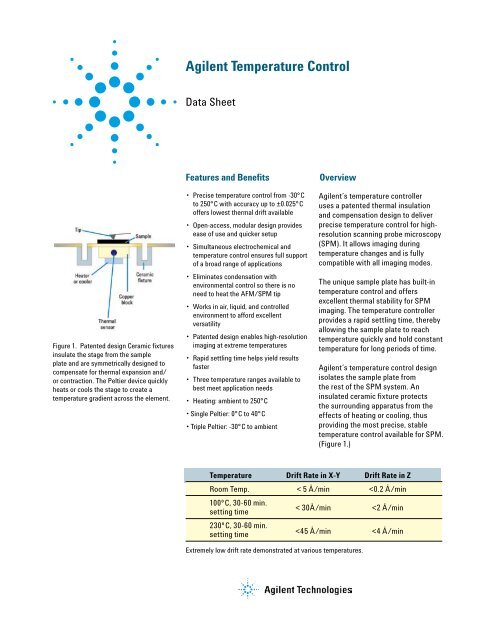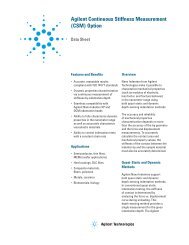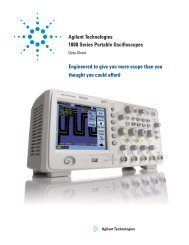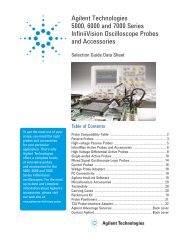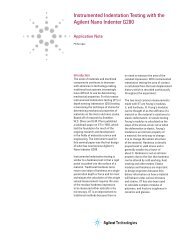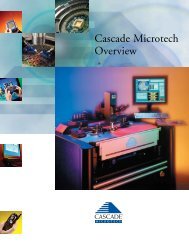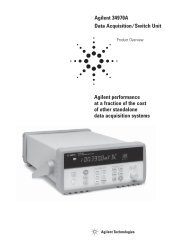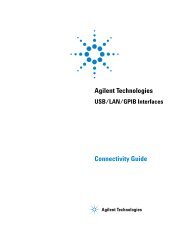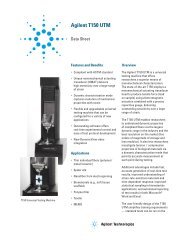AFM Temperature control - H TEST a.s.
AFM Temperature control - H TEST a.s.
AFM Temperature control - H TEST a.s.
Create successful ePaper yourself
Turn your PDF publications into a flip-book with our unique Google optimized e-Paper software.
Agilent <strong>Temperature</strong> ControlData SheetFigure 1. Patented design Ceramic fixturesinsulate the stage from the sampleplate and are symmetrically designed tocompensate for thermal expansion and/or contraction. The Peltier device quicklyheats or cools the stage to create atemperature gradient across the element.Features and Benefits• Precise temperature <strong>control</strong> from -30°Cto 250°C with accuracy up to ±0.025°Coffers lowest thermal drift available• Open-access, modular design providesease of use and quicker setup• Simultaneous electrochemical andtemperature <strong>control</strong> ensures full supportof a broad range of applications• Eliminates condensation withenvironmental <strong>control</strong> so there is noneed to heat the <strong>AFM</strong>/SPM tip• Works in air, liquid, and <strong>control</strong>ledenvironment to afford excellentversatility• Patented design enables high-resolutionimaging at extreme temperatures• Rapid settling time helps yield resultsfaster• Three temperature ranges available tobest meet application needs• Heating: ambient to 250°C• Single Peltier: 0°C to 40°C• Triple Peltier: -30°C to ambientOverviewAgilent’s temperature <strong>control</strong>leruses a patented thermal insulationand compensation design to deliverprecise temperature <strong>control</strong> for highresolutionscanning probe microscopy(SPM). It allows imaging duringtemperature changes and is fullycompatible with all imaging modes.The unique sample plate has built-intemperature <strong>control</strong> and offersexcellent thermal stability for SPMimaging. The temperature <strong>control</strong>lerprovides a rapid settling time, therebyallowing the sample plate to reachtemperature quickly and hold constanttemperature for long periods of time.Agilent’s temperature <strong>control</strong> designisolates the sample plate fromthe rest of the SPM system. Aninsulated ceramic fixture protectsthe surrounding apparatus from theeffects of heating or cooling, thusproviding the most precise, stabletemperature <strong>control</strong> available for SPM.(Figure 1.)<strong>Temperature</strong> Drift Rate in X-Y Drift Rate in ZRoom Temp. < 5 Å/min
Application Suitability<strong>Temperature</strong> <strong>control</strong> plays a criticalrole in SPM research. <strong>Temperature</strong>can be used to modify molecularstructures and accelerate, inhibit, and<strong>control</strong> the rates of many chemicalreactions. In material sciences,temperature is used to <strong>control</strong>phase transition of materials suchas co-polymer and crystal growth.<strong>Temperature</strong> also plays a veryimportant role in life sciences. Forexample, physiological processescan be accelerated or decelerated,the structures of many biologicalmolecules can be altered, andbiomolecular binding events can be<strong>control</strong>led all by heating or cooling.Applicationsa. Beforec. Afterb. DuringFigure 6. MAC Mode <strong>AFM</strong> imageof paraffin at 120°C (a) before and(c) after phase transition, and at126°C (b) during phase transition.10μm x 10μm.• Biomolecular studies: decreasetemperature to stabilize or annealmolecules; increase temperatureto induce melting transition ordenature molecules; performexperiments at physiologicaltemperatureScan size 40 µm x 40 µm Scan size 6 µm x 6 µm• Surface chemistry and polymerstudies: <strong>control</strong> reaction rates;induce phase transitions; inducethermal degradation• Corrosion studies: accelerateoxidation reactions; mimic corrosionconditions• Studies of mechanical or electricaltemperature-dependent propertiesin all applications25° C80° Ca.Figure 7. In situ and temperature-dependent<strong>AFM</strong> studies of polymer low densitypolyethylene (LDPE). The images on the leftare acquired at 25°C (top), 80°C (middle)and 80°C after heating over 95°C (bottom),respectively. It shows that LDPE canwithstand a temperatures of 80°C for a longtime, but heating above 95°C will lead to astructure transition. The two images on theright are in situ zoom-in demonstrate thestructure change to the annealing.80° C after 95° C3


